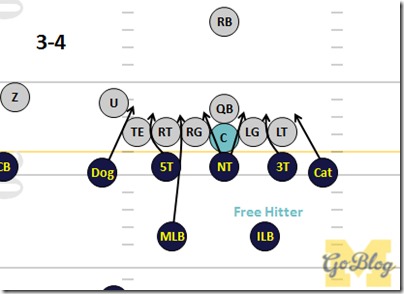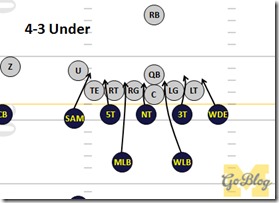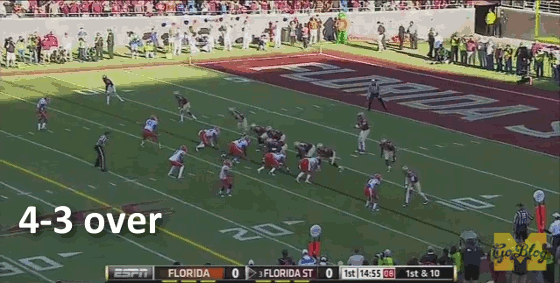No this isn't a "3-4"; well it is a 3-man front with the nose over the center,
but not a 3-4,let me explain.
Various people reporting back from practice have noticed three (or fewer) guys with their hands down, and said "oh they're going 3-4." Soon enough people pick up on this, figure a new DC means a new defense, and whiteboards across the state get sales points erased in favor of X's and O's with arrows diving between X's.
Mattison was asked about the 3-4 look in his breakout Q&A and had this to say:
"We ran that last year. What we're doing on defense is trying to see what scheme fits the players."
I know we've hashed the 4-3 under a bunch on this site but I could never walk by a boardroom with football drawings on it (this is probably why I lost that job) so here we go again.
Everyone Runs Everything. Calling a defense a "3-4" or "4-3" or any one thing at this level is not ever going to be accurate, because defenses change up gaps and show different looks so offensive linemen won't know exactly who's got what gap every time. In the process of showing that you might be running 3-4, sometimes you actually have guys two-gapping. If you have a really special player you might do that even more. But general rule is everyone runs everything, and the best you can do to describe any single defense is what their base is. Everything else will stem from the base.
Alignment vs. Philosophy
Alignment is where you put your players before the snap; philosophy is what they're being tasked with. The two-gapping philosophy has become synonymous with the 3-4 alignment, and the one-gapping philosophy is thus tied to the 4-3. The major difference between these philosophies is understood better by using the "gap" terms.
Two-Gapping
…means you have one to three defensive linemen responsible for controlling a blocker instead of a gap between those blockers. His job is to get into that guy and be in a position to tackle if the run goes to either side. He's not left out to dry; the two-gap philosophy gives you a free hitter from the second level who watches the play then reacts. Think of it as man defense for run fits, i.e. the defenders all have a certain offensive player they're responsible for beating, the free hitter's being the ballcarrier.
You can do this if you have a super large nose tackle, the classic example being Wilfork on the Patriots. You can look at the above diagram and see the downside of two-gapping: if that left guard releases and the center holds up, you have a blocker eating your free hitter downfield. Two-gapping is a luxury you can have if the guy you have two-gapping is able to do it effectively.
A two-gapping defensive lineman needs to get that control established early, so lining up directly over the guy he's going to control is rather important. So a base 3-4, two-gapping defense will line up almost always with the nose tackle directly over the center, thus threatening the two-gap assignment, and still in position to change it up.
Remember that these are not set-in-stone gap assignments, just common ones. You change these up from play to play.
One-Gapping
This is your basic "everyone has a gap" defense and the philosophy behind both the 4-3 even/over and 4-3 under. This is the zone defense of run fits. Coaches who use this as their base, however, call it the more "aggressive," because football coaches describe the way they eat an ice cream cone "aggressive," yes, but also because the linebackers and linemen aren't diagnosing anything before taking their first steps of the play.
Instructively, one of the terms used often for the 4-3 over is the "Miami 4-3" because Jimmy Johnson used it to great effect when he had access to a lot of very athletic yet not very coachable defensive players. The concept was fast guys hitting their gaps and penetrating upfield to cause disruption.
You'll note that the 4-3 under picture is nearly identical to the 3-4, one-gapping example image above. That's pretty much what a 4-3 under is: a nose tackle and two large DL who set up in a position to take on double-teams so the LBs can attack their gaps. Philosophically everyone has one gap, but guys start taking on different roles: the NT is shaded to strongside so he'll need to be a bit more of a plugger; the SDE is further inside and has to be able to take on doubles like a DT; the other DT is further out and can be a little more end-ish; the WDE has a one-on-one battle with the OT, and can be a little more linebackerish; and the SAM has to be part-DE to compensate for the fact that he's the edge defender instead of the SDE.
Because it looks so much like the 3-4 defense it can threated to do 3-4 things. That gets us to the point of what Durkin does with his defenses, and what Michigan is expected to do this year: threaten two-gapping as a changeup.
Example
Here's a play from Florida-FSU last year and you'll recognize the alignment as 3-4 (or would be 3-4 except weakside OLB is pulled for a nickel):
Nose tackle is right over the center. Ends are right over the tackles. You are thinking all sorts of Wilforky things. But this is still a one-gapping defense and you'll see why off the snap:
Right there is a good shot of the roles of 4-3 under defenders. The NT and 3-tech have double-teams; as long as they don't give up ground and stay engaged with those dudes they're keeping the LBs clean and keeping their holes closed. The five-tech has a guard (he'd be doubled if the run was going the other way), and the two MLB-types (the WLB and MLB) can flow into gaps (the MLB is blitzing his). The SAM has his edge. The difference here is the WDE has been pulled for a nickel, a dramatization of the fact that a 4-3 under WDE is often in coverage.
Here's how it's drawn up:
(orange arrow means player's in zone coverage and watching his gap; black=rushing).
On that play the nickelback (5'10"/206 junior Brian Poole, Florida's hybrid space player) came down inside and got blocked by the slot receiver, giving up the edge and leading to a big run since the free safety was deep in coverage. If not for that, Poole should have been in perfect position to hold this down.
You Sure Durkin is a 4-3 Guy?
Durkin likes to accomplish the base thing from a gazillion different looks; I predict defensive UFRs with regular opening shots of Brian trying to name things. Here are the formations for every play leading up to that one:
What defense is this? It's a philosophically 4-3 (one-gapping) multiple-front thing that likes to have speed on the edges, either from standup WDE/SAMs or putting hybrid space players in there with edge responsibility. IE what Michigan's been since 2011.
What About 3-3-5?
The 3-3-5 stack also uses two-gapping as a base threat, though neither Rocky Long nor Jeff Casteel have often had access to a nose tackle capable of doing it consistently. The point of the 3-3-5 is it gives up starting position for the threat of attacking from anywhere.
Remember how GERG was terrible at this? It's because he was a 4-3 coach teaching 4-3 philosophy, and that took away the unpredictability of this defense.









